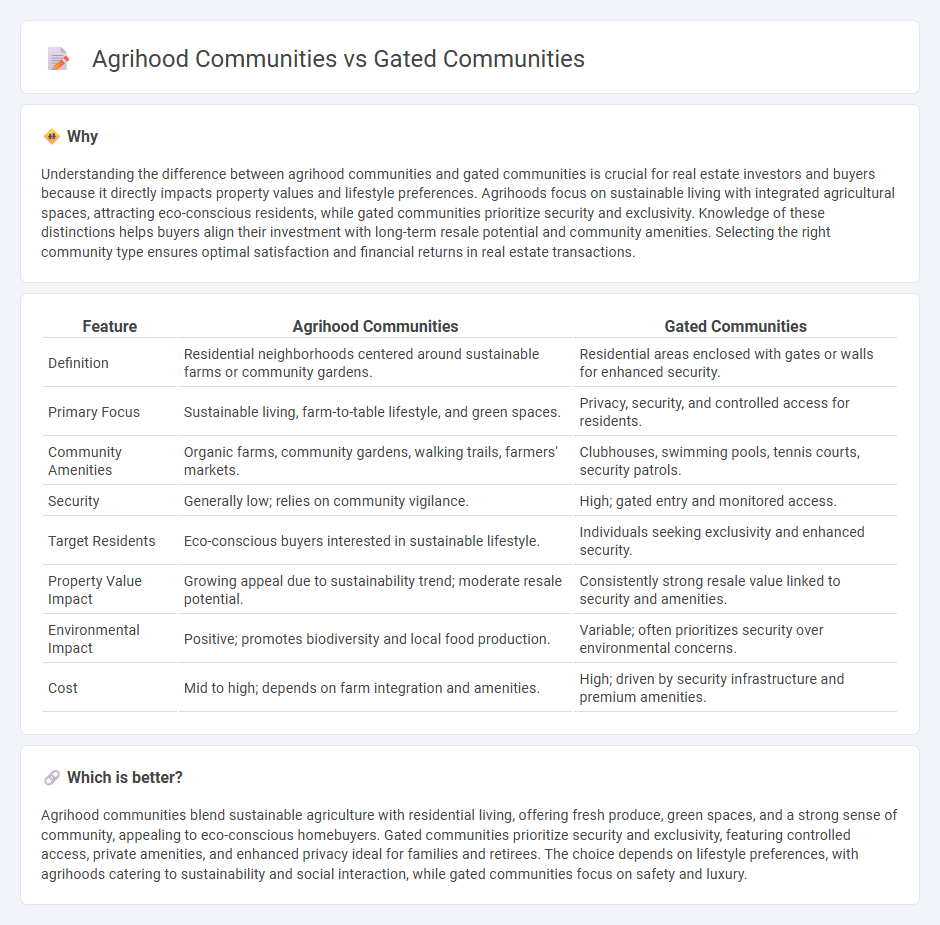
Agrihood communities integrate residential living with sustainable agriculture, offering residents access to organic farms, community gardens, and open green spaces, fostering a lifestyle connected to nature and local food production. Gated communities emphasize security and privacy, providing controlled access, amenities like clubhouses and golf courses, and often a more structured, suburban environment. Explore the distinct benefits and lifestyle choices in agrihood versus gated communities to find the best fit for your real estate investment.
Why it is important
Understanding the difference between agrihood communities and gated communities is crucial for real estate investors and buyers because it directly impacts property values and lifestyle preferences. Agrihoods focus on sustainable living with integrated agricultural spaces, attracting eco-conscious residents, while gated communities prioritize security and exclusivity. Knowledge of these distinctions helps buyers align their investment with long-term resale potential and community amenities. Selecting the right community type ensures optimal satisfaction and financial returns in real estate transactions.
Comparison Table
| Feature | Agrihood Communities | Gated Communities |
|---|---|---|
| Definition | Residential neighborhoods centered around sustainable farms or community gardens. | Residential areas enclosed with gates or walls for enhanced security. |
| Primary Focus | Sustainable living, farm-to-table lifestyle, and green spaces. | Privacy, security, and controlled access for residents. |
| Community Amenities | Organic farms, community gardens, walking trails, farmers' markets. | Clubhouses, swimming pools, tennis courts, security patrols. |
| Security | Generally low; relies on community vigilance. | High; gated entry and monitored access. |
| Target Residents | Eco-conscious buyers interested in sustainable lifestyle. | Individuals seeking exclusivity and enhanced security. |
| Property Value Impact | Growing appeal due to sustainability trend; moderate resale potential. | Consistently strong resale value linked to security and amenities. |
| Environmental Impact | Positive; promotes biodiversity and local food production. | Variable; often prioritizes security over environmental concerns. |
| Cost | Mid to high; depends on farm integration and amenities. | High; driven by security infrastructure and premium amenities. |
Which is better?
Agrihood communities blend sustainable agriculture with residential living, offering fresh produce, green spaces, and a strong sense of community, appealing to eco-conscious homebuyers. Gated communities prioritize security and exclusivity, featuring controlled access, private amenities, and enhanced privacy ideal for families and retirees. The choice depends on lifestyle preferences, with agrihoods catering to sustainability and social interaction, while gated communities focus on safety and luxury.
Connection
Agrihood communities and gated communities share a focus on privacy, security, and lifestyle enhancement, attracting homebuyers seeking a close-knit neighborhood with controlled access. Both types of developments often integrate shared amenities, with agrihoods emphasizing sustainable agriculture and green spaces, while gated communities prioritize exclusivity and safety. These connections create residential environments that blend community engagement with protection and well-being in real estate markets.
Key Terms
Security
Gated communities prioritize high-level security measures such as controlled entrances, CCTV surveillance, and on-site security personnel to ensure residents' safety. Agrihood communities also implement security features but often emphasize integrating natural surveillance through open green spaces and community engagement. Explore the distinctive security advantages and lifestyles offered by gated communities and agrihoods to determine the ideal living environment.
Sustainability
Gated communities often prioritize security and exclusivity, with limited integration of sustainable practices, whereas agrihood communities center around sustainable agriculture, green spaces, and eco-friendly living to promote environmental stewardship. Agrihoods incorporate community gardens, renewable energy sources, and water conservation systems, fostering a strong connection between residents and nature. Discover how these community models impact sustainability and quality of life in modern living environments.
Amenities
Gated communities often feature security enhancements, clubhouses, swimming pools, and manicured landscapes designed for privacy and luxury living. Agrihood communities emphasize sustainable agriculture amenities such as community gardens, orchards, farm-to-table dining, and green spaces promoting environmental stewardship. Explore more to discover how the distinct amenities in these communities shape lifestyle choices and community engagement.
Source and External Links
Pros And Cons Of A Gated Community - This article explores the benefits and drawbacks of living in a gated community, including enhanced security and privacy, luxury amenities, and potential drawbacks like isolation and high costs.
Why do people choose to live in gated communities? - This piece discusses why people opt for gated communities, focusing on security, privacy, and exclusivity as key reasons, alongside the historical context of their emergence.
What is a gated community? - This article provides an overview of gated communities, including their definition, benefits, and types, as well as practical considerations for buying a home in such communities.
 dowidth.com
dowidth.com